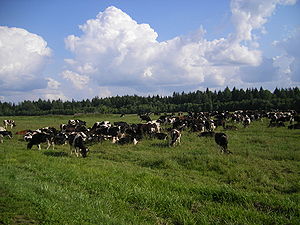
Agriculture in Belarus can be divided into two segments: livestock production and crop production. Crop production slightly outweighs livestock production in the country's product mix, accounting for around 55% of gross agricultural output since 1995. Agriculture accounted for 7.9% GDP in 2013, while over the same year that sector accounted for only 3% GDP in the EU.
Products of animal origin are mainly pork, beef, and poultry. Belarus has about 1.5 million cows, but the milk yields are relatively low (less than 3,000 kg per cow per year). Belarus's main crop products are barley, rye, oats, and wheat, as well as potatoes, flax, rapeseed, and sugarbeets. Cereals and legumes (mainly barley and rye) take up 41% of sown area and another 43% is under crops used for animal feed. Potatoes and vegetables take up 11% of sown area and industrial crops (sugarbeets, flax, and some rapeseed) the remaining 4%.
Synopsis

Belarus has been characterized by some as a slow land reformer compared to other CIS countries.
There have been no major shifts in the number of animals between collective and family farms since independence in 1995: the family farm sector (mainly household plots) controlled 11%–16% of the total cattle herd and 30%–40% of the number of pigs between 1980 and 2005. Poultry, on the other hand, has become concentrated to a greater extent in collective farms, with the share of family farms dropping from more than 40% in the 1980s to less than 30% since 1995.
The share of agriculture in GDP declined from 11.6% in 2000 to 7.4% in 2007, while the share of agriculture in total employment dropped from 14.1% to 9.9% over the same period. The decrease in agricultural employment is a long-term trend and back in the early 1990s agriculture's share was as high as 19% of the number of employed. The decrease of agricultural labor parallels the general urbanization trends, as the share of rural population in Belarus steadily declines over time.
In April 2022, Belarusian President Alexander Lukashenko ordered to mobilize schoolchildren to harvest potatoes and apples in Belarus's agricultural industry, which is an example of child labour exploitation, however Lukashenko himself described it as "happiness".
Production
Belarus produced in 2018:
- 5.8 million tons of potato (11th largest producer in the world);
- 4.8 million tonnes of sugar beet, which serves to produce sugar and ethanol;
- 1.8 million tons of wheat;
- 1.1 million tons of maize;
- 1 million tons of triticale (3rd largest producer in the world, only behind Poland and Germany);
- 944 thousand tons of barley;
- 700 thousand tons of apple (19th largest producer in the world);
- 502 thousand tons of rye (5th largest producer in the world);
- 456 thousand tons of rapeseed;
- 360 thousand tons of cabbage;
- 346 thousand tons of vegetable;
- 341 thousand tons of oats (18th largest producer in the world);
- 290 thousand tons of carrot;
- 284 thousand tons of tomato;
- 240 thousand tons of beans;
- 226 thousand tons of cucumber;
- 215 thousand tons of onion;
In addition to smaller productions of other agricultural products.
See also
References
- ^ Statistical Yearbook of the Republic of Belarus 2004, BelStat, Minsk, 2004
- "LIVESTOCK FARMING" (PDF). CJSC Investment company Uniter. November 2013.
- C. Csaki and H. Kray, The Agrarian Economies of Central-Eastern Europe and the CIS: An Update on Status and Progress in 2004, World Bank, ECSSD Working Paper No. 40, June 2005.
- Official Statistics of the Countries of the Commonwealth of Independent States, CD-ROM 2006-11, Interstate Statistical Committee of the CIS, Moscow, 2006.
- Sectoral structure of GDP 2000-2007 Archived December 3, 2008, at the Wayback Machine, BelStat.
- Employment by sector 2000-2007 Archived December 3, 2008, at the Wayback Machine, BelStat.
- "Mobilise children to harvest potatoes and apples, says Lukashenko". Euronews. 4 October 2022. Retrieved 8 August 2023.
- Belarus production in 2018, by FAO
Other sources
- CIA World Factbook: Belarus
- Library of Congress Country Studies: Belarus
- Belarus Digest: Belarus Agriculture: Success Abroad, Failure At Home Archived 2017-05-05 at the Wayback Machine
| Agriculture in Europe | |
|---|---|
| Sovereign states |
|
| States with limited recognition | |
| Dependencies and other entities | |
| Other entities | |
| Belarus articles | |||||
|---|---|---|---|---|---|
| History | |||||
| Geography | |||||
| Politics | |||||
| Economy | |||||
| Society |
| ||||